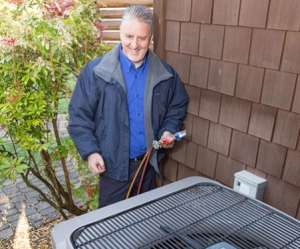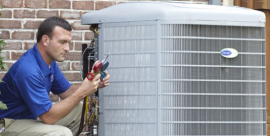- Kenmore refrigerator water filters
- Whirlpool refrigerator water filters
- Samsung refrigerator water filters
- GE refrigerator water filters
- LG refrigerator water filters
- Frigidaire refrigerator water filters
- KitchenAid refrigerator water filters
- Maytag refrigerator water filters
- Kenmore Elite refrigerator water filters
- Estate refrigerator water filters
- GE Profile refrigerator water filters
- Amana refrigerator water filters
- Bosch refrigerator water filters
- Dacor refrigerator water filters
- Electrolux refrigerator water filters
How to prevent the 2 most common AC failures from ruining your summer


Act now and you can be prepared to quickly fix 2 of the most common failures in most central air conditioners. In-home HVAC repair technicians visit millions of home each summer and encounter 2 prevalent problems. These issues are easy for the technicians to fix.
One common HVAC problem is a clogged condensate drain line. This failure is often easy to fix and prevent. The other common HVAC failure is a failed capacitor on the outside condenser unit. A technician typically needs to fix this problem, but you can take steps to be prepared to quickly fix this failure.
How to keep the air conditioner condensate drain clear
Follow the directions in the owner’s manual for your air conditioner to keep the condensate drain clear so water drains freely to the outside of your home. For many central AC systems, you’ll need to pour a cup of liquid chlorine bleach or vinegar down the standpipe in the condensate drain monthly. If you haven’t completed this important maintenance task lately, we recommend that you do it now. Place a container under the drain pipe outside your home to catch the vinegar or bleach to prevent harm to plants and/or grass. Make sure that the bleach or vinegar makes it all the way through the drain pipe and drains into the container.
Monitor the water dripping from the end of the drain pipe at the outside of your home. During summer when the AC is running, you should see the ground wet below that pipe. If the ground under that pipe dries up, you’ll likely need to unclog the drain.
How to unclog the air conditioner condensate drain
You’ll need to take action quickly when you discover that your central air conditioner’s condensate drain pipe is clogged. Many AC systems use a float switch that shuts down the indoor unit if the condensate drain pipe clogs and water backs up in the pipe to trip the float switch.
Two tools that can help you quickly unclog a condensate drain pipe are a wet/dry shop vacuum and a plumber’s snake. Having these tools on hand can help you clear the condensate drain and restore AC cooling quickly.
When the drain tube gets clogged, you may be able to suck the clog out using the wet/dry shop vacuum. Place the end of the shop vac hose over the end of the drain hose outside your home and try to suck the clog out from that end of the condensate drain system.
If the shop vac won’t remove the clog, use a plumber’s snake to clear the drain pipe. Carefully push the plumber’s snake into the end of the drain hose at the outside of your home and thread it through the pipe. Once you pull the snake out, the clog and backed up condensate water will likely come out of the end of the drain hose.
If these tips don’t help, you’ll likely need to have a service technician visit your home and unclog the drain hose. Sears has same day and next day HVAC repair service available in many areas.
How to be prepared for a capacitor failure
The average life span of a dual run capacitor on the outside unit of your central air conditioner system is about 10 years. But, the capacitor can fail at any time.
You can be prepared for a capacitor failure by ordering a replacement capacitor for your model of air conditioner and storing it at your home. Although most HVAC service technicians will have the capacitor available in their truck stock when they visit your home to replace it, there’s no harm in having one on hand yourself in case the technician is out of the capacitor for your unit. Having the capacitor on hand at your home can get your air conditioner running again quickly.
To order a replacement capacitor for your AC unit, look up the part using the model number of your central air conditioner. Key in the model number in the search field at the top of this page and find the capacitor in the parts list. Order the part and store it in a location that you’ll remember so you can have it ready if needed.
Symptoms of a bad AC capacitor
You’ll want to be aware of the symptoms of a failed dual run capacitor so that you can act quickly when it goes bad. You’ll typically see these things happening when the dual run capacitor in the outside condenser unit of your central AC goes bad.
The AC blows warm air
When this happens, you’ll want to immediately check to see if the condenser fan and compressor are running in the outside unit of your AC system. When the dual run capacitor goes bad, the compressor and condenser fan won’t start and run. You may find that the circuit breaker tripped. Resetting the circuit breaker may restore power to the outside unit, but the compressor and condenser fan still won’t start with a bad capacitor. Set up AC repair service as soon as you discover that the compressor and condenser fan isn’t running on your outside AC unit.
Humming noise from the outside unit
You may hear an unusual humming noise from the outside unit when the capacitor is going bad. The capacitor may have intermittent problems starting the compressor and/or condenser fan motor so you may experience occasional cooling problems when the capacitor is going bad. At the first signs of trouble, schedule service to have your AC system fixed.
Burning smell coming from the outside condenser unit
A bad capacitor will emit a burning smell that you may be able to detect coming from the outside unit. You may experience intermittent cooling problems because the capacitor isn’t able to start the compressor and/or condenser fan motor. Set up service as soon as possible when you detect a burning smell coming from the outside condenser unit of your central air conditioner.
High electric bills
A failing capacitor can cause your electric bill to shoot up drastically. When this happens, it’s time to get your AC system checked immediately.
Have your air conditioner professionally maintained yearly
To help prevent AC problems from occurring, have your heating and cooling system checked by a Sears Technician annually. During professional maintenance service, the tech will:
Check electrical connections and components (including the capacitor).
Make sure the system controls and safety circuits work properly.
Lubricate the blower motor, if applicable.
Check the central air conditioner condenser coil and clean it, if appropriate.
Check and clean the condensate drain line.
Check the evaporator for adequate air flow.
Here’s a video that shows more details about professional AC maintenance performed by a Sears Technician.
Having your central air conditioner professionally maintained every year will help prevent problems with the condensate drain line and dual run capacitor. The technician will see any potential problems during the maintenance service and correct them before you lose cooling in the middle of summer.
Take the steps you need to keep your air conditioner in top shape and running smoothly all summer long.
Effective articles & videos to help repair your central air conditioners

Learn how to maintain your central air conditioner to keep it running smoothly all summer long.…

Get tips to help keep your central AC running all summer long…

Get answers to frequently asked questions about Sears and Sears PartsDirect.…